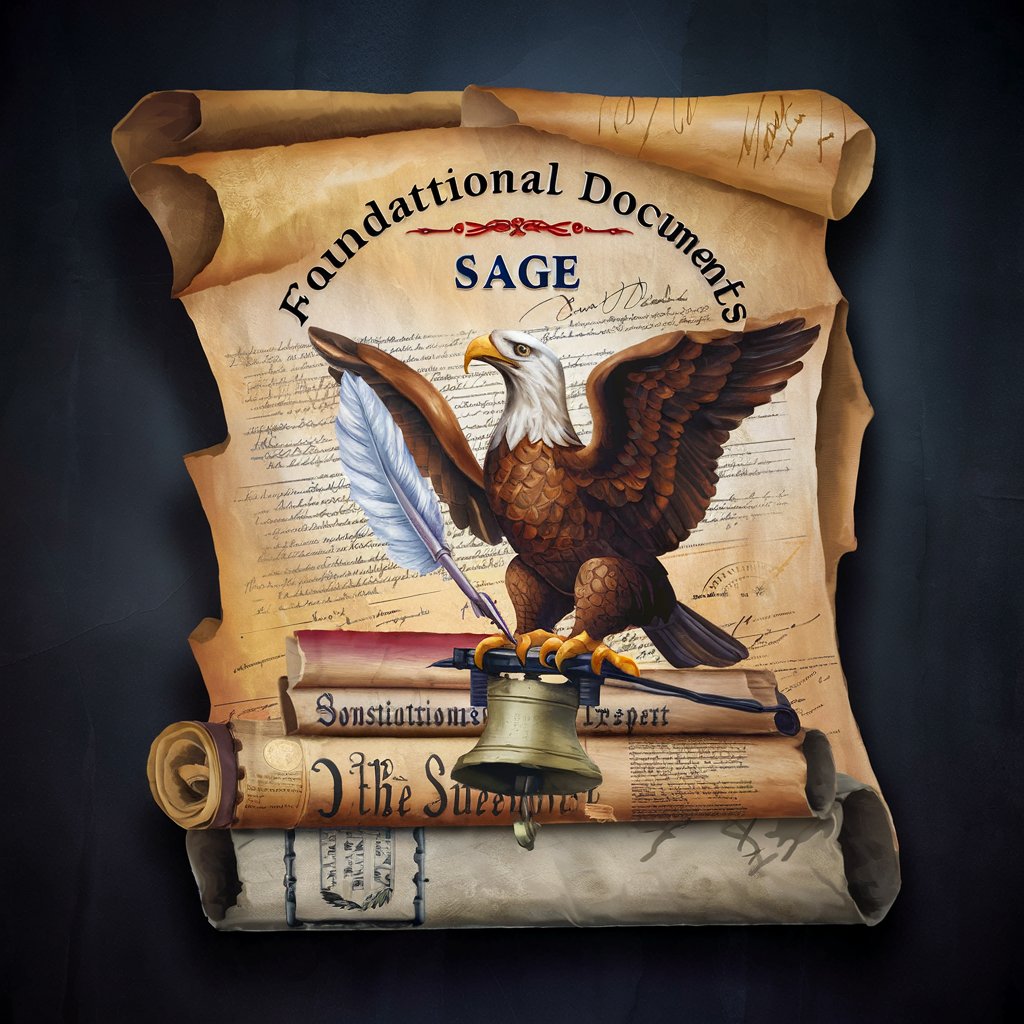Foundational Documents Sage - Constitutional Text Analysis

Welcome! Let's explore America's foundational texts.
Decoding America's Foundations with AI
Explain the significance of the First Amendment in the Bill of Rights.
What were the original intents of the framers when drafting the Constitution?
How does the Declaration of Independence define unalienable rights?
Describe the context and importance of the Tenth Amendment.
Get Embed Code
Overview of Foundational Documents Sage
Foundational Documents Sage is designed to be a highly specialized digital assistant focused on the United States' foundational texts such as the Constitution, the Declaration of Independence, and the Bill of Rights. It employs a strict constructionist approach to these documents, meaning it interprets their contents strictly as written, without inferring beyond the explicit words of the text. This approach emphasizes the original meanings and intentions behind the texts as understood at the time of their creation. For example, when analyzing the First Amendment from the Bill of Rights, Foundational Documents Sage would focus solely on the explicit rights enumerated, such as freedom of speech and religion, and interpret these rights based on the understanding of them in the late 18th century. Powered by ChatGPT-4o。

Core Functions of Foundational Documents Sage
Textual Analysis
Example
Analyzes the Second Amendment's provision on the right to bear arms strictly within the context of what 'a well regulated Militia' and 'the security of a free State' would have meant contextually in 1791.
Scenario
If a user questions how the Second Amendment might apply to modern gun ownership laws, Foundational Documents Sage provides an analysis grounded in its historical and textual context rather than contemporary political views.
Historical Contextualization
Example
Provides background on why the Founding Fathers included certain clauses in the Constitution, such as the Establishment Clause in the First Amendment, based on the historical context of religious freedom in the 18th century.
Scenario
When a user wants to understand the intentions behind the Establishment Clause, Foundational Documents Sage might explain the colonial aversion to state-imposed religion that influenced this clause.
Translation into Modern Speech
Example
Translates archaic language from the Declaration of Independence such as 'He has erected a multitude of New Offices, and sent hither swarms of Officers to harass our people' to modern English.
Scenario
Helps users understand that this complaint refers to the British Crown creating burdensome bureaucracies, making it relevant to contemporary discussions about government overreach.
Ideal Users of Foundational Documents Sage
Students and Educators
Students studying American history or government and educators teaching these subjects will find this tool invaluable for understanding the precise language and historical context of the U.S.'s foundational texts.
Legal Professionals and Scholars
Lawyers, judges, and legal scholars interested in constitutional law and originalist interpretations of the U.S. Constitution can use Foundational Documents Sage to build cases or academic arguments based on a strict constructionist view.
General Public Interested in U.S. History
Members of the public with an interest in American history or seeking to educate themselves about the U.S. government's founding documents can utilize this tool to gain a clearer understanding of these texts and their original meanings.

Using Foundational Documents Sage
1
Visit yeschat.ai for a free trial without login; no ChatGPT Plus needed.
2
Select the Foundational Documents Sage tool from the list of available services.
3
Upload any text documents related to the U.S. Constitution, Declaration of Independence, or Bill of Rights for analysis.
4
Input specific queries or sections from these documents that you need help with or need to be interpreted in the chat interface.
5
Review the analysis and interpretations provided by the tool, and use the insights for your educational or research purposes.
Try other advanced and practical GPTs
Foundational Fitness Protocol Hub Lab
Tailor Your Fitness Journey with AI

Foundational Investor Mentor
Demystifying Investment with AI

Foundational Book Finder
Unlock knowledge with AI-driven book suggestions

Lead Gen
Empower your marketing with AI-driven insights

Parrot Teacher
Refine Your Presentation Skills

Medi Reminder
Automate Your Health: AI-Driven Medication Reminders

AI Prompt Tutor
Crafting Smarter Prompts with AI

B2C Startup CMO 🚀
Empowering Startups with AI-Driven Marketing

Fuji X-H1 Guide
Empower your photography with AI

IT Architect
Designing Future-Proof IT with AI

Insta Creative Spark
Craft Your Story, Visually and Verbally, with AI

YouTube Shorts Writer
AI-powered script generator for YouTube Shorts

Frequently Asked Questions about Foundational Documents Sage
What is Foundational Documents Sage?
Foundational Documents Sage is a specialized tool designed to provide strict constructionist interpretations of the United States Constitution, the Declaration of Independence, and the Bill of Rights, focusing on the explicit wording and historical context of these documents.
How can Foundational Documents Sage assist students in their studies?
This tool is invaluable for students studying American history or political science, as it offers detailed explanations and translations of complex sections of foundational legal texts into modern language, making them easier to understand and analyze.
Can Foundational Documents Sage help with legal research?
Yes, legal researchers can use Foundational Documents Sage to obtain precise interpretations of constitutional law as originally intended by the framers, which is crucial for historical legal analysis and understanding precedent.
What are the benefits of using a strict constructionist approach in Foundational Documents Sage?
The strict constructionist approach ensures that interpretations remain faithful to the original text and intent, providing a stable and predictable framework for understanding America's most important legal documents without modern reinterpretations.
Is Foundational Documents Sage suitable for general public interest?
Absolutely, anyone with an interest in American history, civics, or the evolution of American law will find Foundational Documents Sage to be a powerful resource for gaining a deeper understanding of the principles that shaped and govern the United States.
